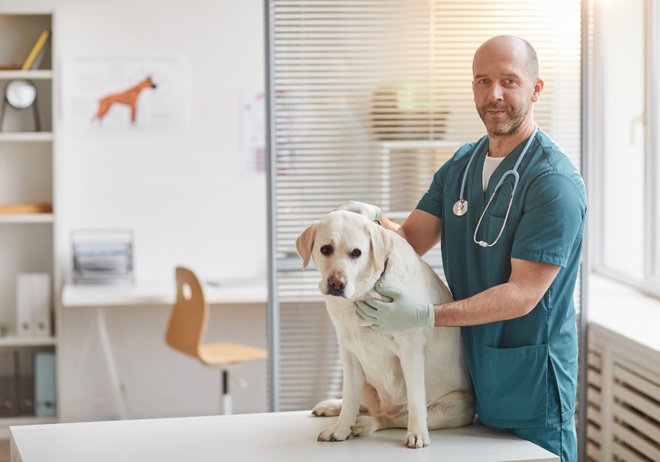How to microchip a dog or a cat?
Do you want to know more about microchipping before having your pet chipped? In this article you will find all the information you need to know about the steps to follow to have your pet identified.

Reading time : 4 min
Microchipping is a technology that allows you to locate your dog or cat if it is lost or stolen. Collars and tags can be helpful when you need to find a missing pet, but there is always a risk that they will fall off or become illegible over time. A microchip, on the other hand, is placed under the skin of your pet and is therefore a more reliable and permanent form of identification.
Without identification, the dog warden cannot let you know that your pet has been found. After seven days, your pet may be passed to a rehoming charity, or they may be euthanised by the local authority. It is therefore very important to have your pet microchipped. This article explains the different steps to follow in order to microchip your pet.
TOPICS
Why should you get your pet microchipped?

Protects against pet thefts
Purebred pets can be a source of envy for unscrupulous neighbours or people. A pedigree dog or cat is expensive. It could therefore be stolen by someone who wants to adopt a purebred pet at a lower cost in order to make some profit.
A chipped animal has an official owner. If the owner notices the theft, it is quite possible for him to prove that the cat or dog belongs to him and to report it to the authorities.
This is because the owner holds the dog or cat identification card which corresponds to the pet ID number, which itself contains the owner’s details.
In order to travel
In order to take your pet with you on a trip, it must be correctly identified. A microchip is required when travelling with your pet abroad and throughout the EU. The microchip number will also be recorded on your pet’s passport, another entry requirement for your dog or cat.
If you are travelling, your pet's microchip must be an ISO standard 15-digit microchip. You must bring your own microchip reader if your pet's microchip does not meet ISO standards.
In case of emergency
If you have to leave your home in a hurry due to an emergency or disaster, you may not always have time to ensure that your cat or dog is properly transported during the evacuation. If your pet is accidentally released during a crisis situation (fire, earthquake, hurricane, etc.), you will have a much better chance of finding your beloved pet if it is microchipped.
There have been a number of noteworthy incidents of microchipped cats being returned home, sometimes from far away, because their microchips were scanned by vet clinics or animal-shelters.
Who can microchip a dog or a cat?

The procedure is quick, relatively painless, and does not cause lasting discomfort if done properly. Microchipping may feel like a blood test, and most pets recover instantly without distress at the implantation site. Although it looks like a simple injection between the shoulder blades, don't attempt it yourself.
It is very important that this small microchip, the size of a grain of rice, is implanted correctly. Implanting the hypodermic needle with too much force, too deeply, or in the wrong place can not only make it difficult to detect or read the chip, but it can also damage your pet’s health, leading to life-threatening problems.
Microchips should always be injected by a qualified health veterinary professional, as they know exactly where to place the chip, how to insert it safely, and how to spot any potential issues at the implantation site that may need attention.
When to microchip your pet?

During a routine visit to the vet
It is advisable to wait until the dog or cat is 8 weeks old before having it microchipped. The sensation of microchip implantation is similar to a routine vaccination. The procedure can therefore be carried out during a routine visit to the vet as no surgery or anaesthetic is required.
During a procedure that requires anaesthetic
However, to reduce discomfort, many pet owners choose to chip their pet under anaesthetic for another procedure, such as neutering or spaying. Many kittens are chipped under anaesthetic because they are more fragile.
Obviously, if the pet is already chipped when you adopt it, it will no longer be necessary to have it microchipped. All you have to do is contact the database where the pet is registered to update the information.
Just microchipping isn’t enough

Register your pet
When your pet is microchipped, you must complete the microchip paperwork and register the chip with a DEFRA-approved microchipping database. This is a legal requirement under the Microchipping of Cats and Dogs (England) Regulations 2023. The contact details you provide link you as the legal owner, or “keeper” under UK law.
If your pet is already microchipped, such as after adoption, you must update the microchip database with your own information. This update is usually included in the adoption fee. You must ensure that the registration of contact details is completed in a compliant database. You cannot change the database.
Not sure where your pet is registered? Use its chip number in a microchip lookup tool to identify the correct database and ensure it contains your up-to-date details. In England, you have 21 days to comply with this regulation. Failure to register your pet correctly may result in a fine of up to £500.
Keep your information up to date.
Whenever you move, change your phone number, or adjust other personal data, don’t forget to update your contact details in the relevant microchip database.
You can do this online or by calling the registry. Changing your contact details avoids errors and increases the chances of being reunited with your pet.
This responsibility involves a small cost initially, but there are no ongoing costs if you keep the same DEFRA-approved microchipping database. It’s a low fee for lifelong peace of mind and a crucial part of being a responsible pet keeper.
Conclusion
Having your pet microchipped is a way of ensuring its safety by giving it an official existence and giving yourself every chance of finding and being reunited with your lost pet. Make sure you take your pet to the vet, as this is a veterinary procedure.
But pet identification alone is not enough, you must ensure that throughout the life of the animal you report any change of address or owner to the database in which you have registered your registration information so that the chip stays functional.
Continue reading our guide
This article is part of a complete guide on the subject. Do not miss the next chapters.
Are you an expert on pet microchipping?
Test your knowledge!
Answer our 7 questions on pet microchipping.
